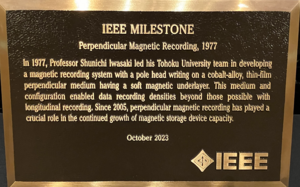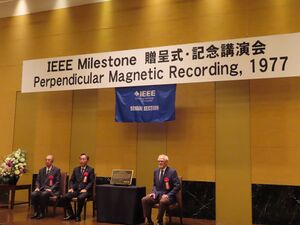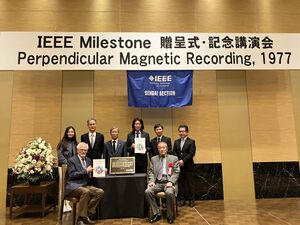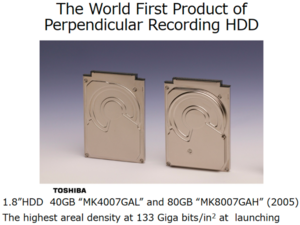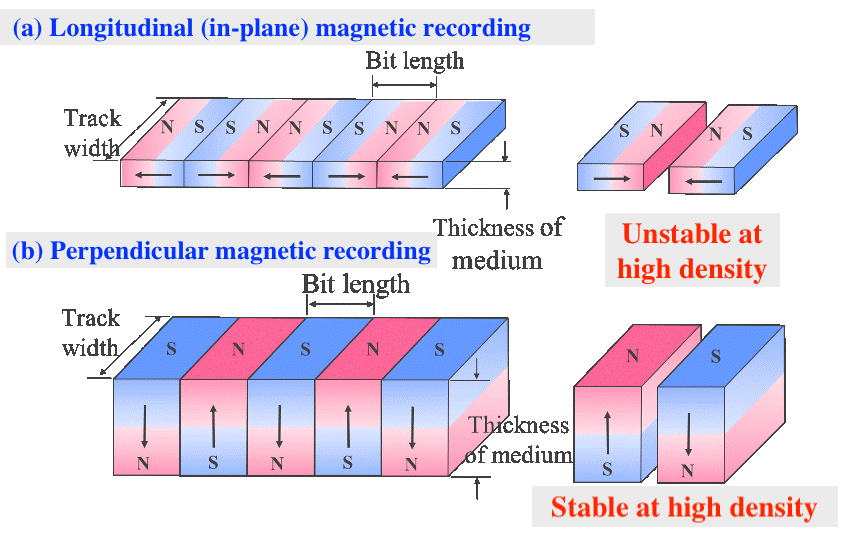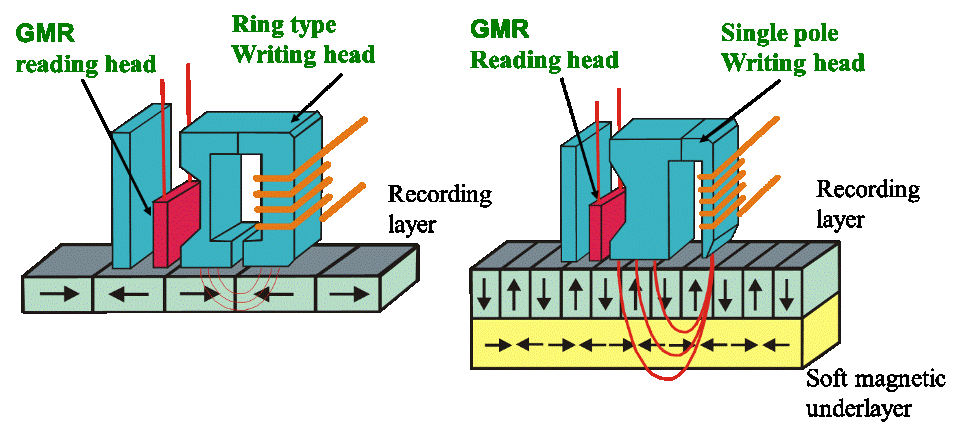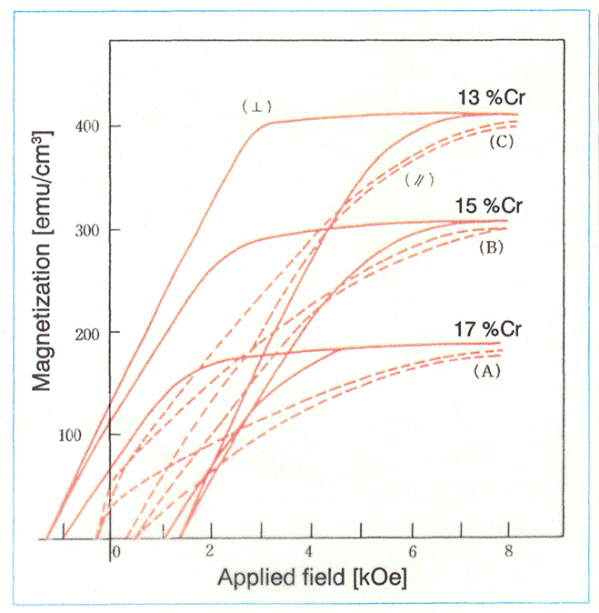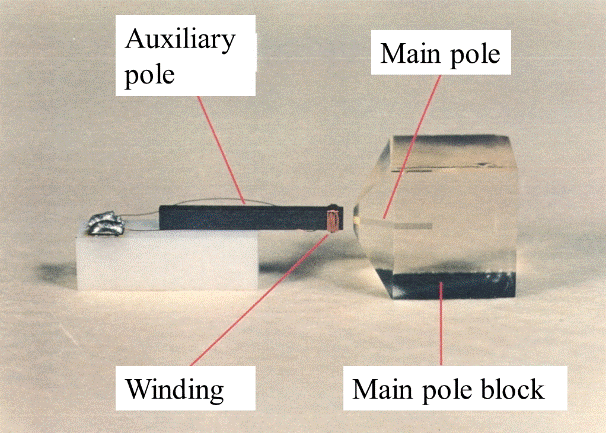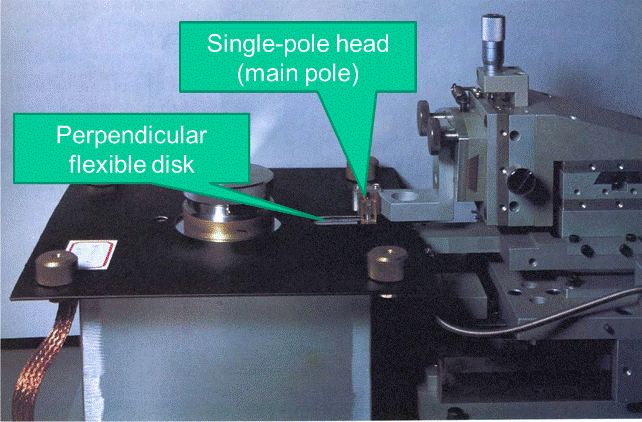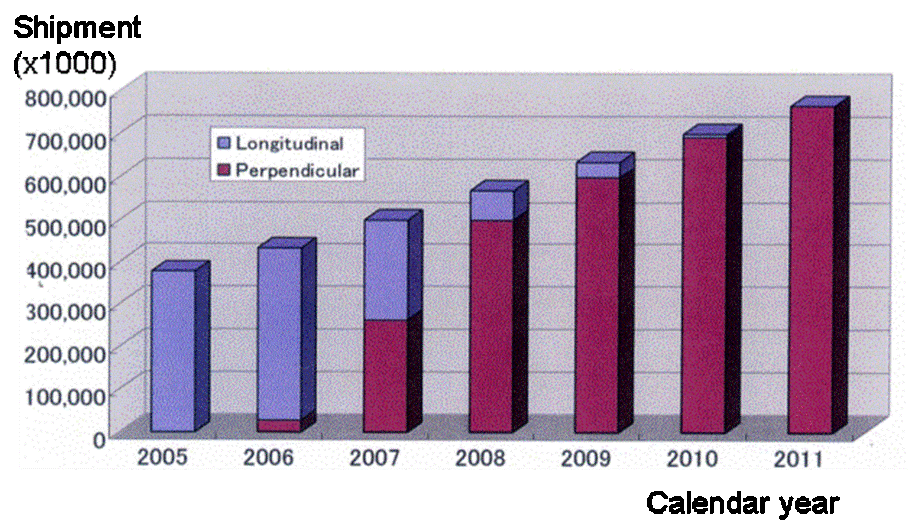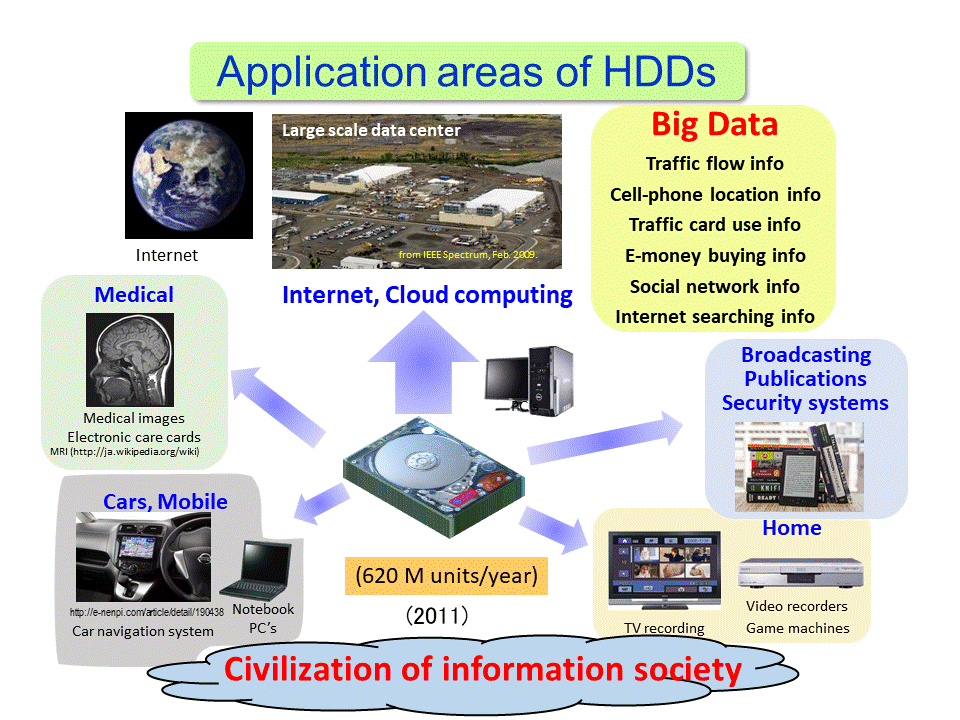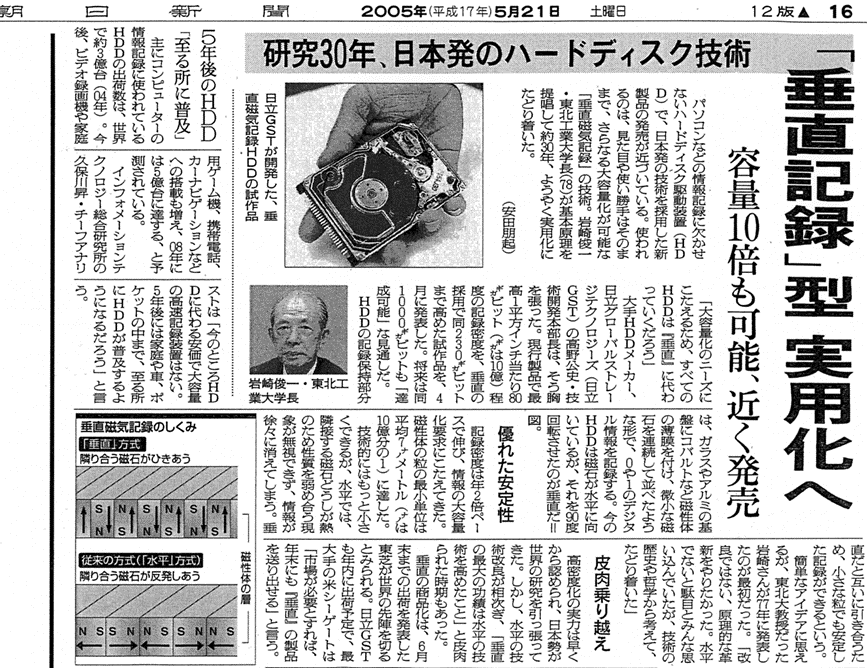Milestones:Perpendicular Magnetic Recording, 1977
Title
Perpendicular Magnetic Recording, 1977
Citation
In 1977, Professor Shunichi Iwasaki led his Tohoku University team in developing a magnetic recording system with a pole head writing on a cobalt-alloy, thin-film perpendicular medium having a soft magnetic underlayer. This medium and configuration enabled data recording densities beyond those possible with longitudinal recording. Since 2005, perpendicular magnetic recording has played a crucial role in the continued growth of magnetic storage device capacity.
Street address(es) and GPS coordinates of the Milestone Plaque Sites
Tohoku University Archives, 2-1-1 Katahira, Aoba-ku, Sendai 980-8577, Japan, (GPS: 38.253458, 140.873355).
Details of the physical location of the plaque
On the wall in the Tohoku University Archives building.
How the plaque site is protected/secured
The plaque is protected with other valuable historical materials by the Tohoku University Archives. Public access is during daytime hours on weekdays. Visitors must show an ID card issued by the office in the building.
Historical significance of the work
The most important significance is that perpendicular magnetic recording (PMR) opened a new paradigm of high areal density magnetic recording. PMR is the original invention by Professor Dr. Shun-ichi Iwasaki, Tohoku University, Sendai, Japan, in 1977 [1]. It is one of the most fundamental innovations in magnetic recording history, which has realized large-capacity storage technology which is indispensable for the present “big data” society. The significance of PMR is recognized as scientific, industrial, and social aspects.
Innovation of high density magnetic recording
PMR achieved high areal density recording by aligning the recorded magnetization perpendicular to the medium surface. Prior to PMR in longitudinal magnetic recording, recorded magnetization was oriented in-plain, or parallel to the surface. The contrast is schematically shown in Fig. 1, where the bit length corresponds to the length of each magnetization, or magnet, bearing one bit. At low densities, the recorded longitudinal magnetization is stable, because the demagnetization field is small. In contrast, at high densities, short bit lengths induce a large demagnetization field in the recorded bits that destabilizes the recorded magnetization. To avoid this difficulty, the recording medium should be made thinner, but in that case, the small bit volume made readout signals too small to detect without read-errors. PMR fundamentally changed this situation by changing the direction of the recorded magnetization. As indicated in the figure, anti-parallel magnetization states are formed in PMR, which reduces the demagnetization field at short bit lengths, or high linear densities. The first scientific significance is to realize this complementary nature of magneto-static energy in the recording medium [5]. Because of the superior high density performance, PMR was recognized as the next generation disk technology even in the 1980s [6].
Fig. 1 Magnetization in the medium in perpendicular magnetic recording and conventional longitudinal recording.
Three key devices were newly developed to realize PMR: the discovery of cobalt-chrome (Co-Cr) thin films [3], the development of a perpendicular writing head that generated a dominant perpendicular field, referred to as a shingle-pole head in 1978 [2] and the invention of double-layer media, which significantly enhanced the head field strength [4].
Fig. 2 schematically illustrates the head and medium structure of PMR (right) compared with longitudinal recording (left). In order to realize high areal density PMR, both Co-Cr perpendicular anisotropy medium and a single-pole writing head with a soft magnetic underlayer are indispensable. It should be stressed that, without the perpendicular anisotropy medium, stable perpendicular magnetization cannot be maintained, as was widely recognized [7].
Fig. 3 shows magnetic characteristics, hysteresis loops, of the Co-Cr films developed in 1978 [3]. The square solid curves for a perpendicularly applied field indicated strong perpendicular anisotropy, while the thin loops for in-plain field demonstrate good perpendicular orientation.
The single-pole head generates the dominant perpendicular field that penetrates the medium. The soft-magnetic underlayer of the medium enhances the writing field strength and gradient by the magnetic image effect. Fig. 4 shows an early single-pole head developed for tape recording experiments in late 1970s. These media and heads developed in the early stages were used to study the fundamental performance of PMR. The experimental setup of write and read operation with a perpendicular flexible disk and a single-pole head was accomplished, as shown in Fig. 5. Spin-stand testing, which is a kind of practical experiment, was carried out with a Co-Cr flexible disk and a single-pole head before 1980.
Fig. 2 Structure of writing and reading heads and recording medium in perpendicular magnetic recording (right) and conventional longitudinal recording (left).
Fig.3 Magnetic characteristics of Co-Cr perpendicular anisotropy films. Solid line: perpendicular applied field, broken line: in-plain applied field.
Fig. 4 Early single-pole perpendicular head developed for tape recording experiments.
Fig. 5 Spin-stand testing for integrated write and read PMR experiments in 1980s.
In high areal density recording, another physical difficulty appeared in longitudinal recording, which was the thermal stability limit. Thermal energy at room temperature randomly disturbs the recorded magnetization, which causes probabilistic magnetization reversal. Because of these random reversals, the recorded information may randomly disappear, and therefore, is “forgotten”. The thermal stability is governed by the ratio of magnetic energy and thermal energy. The magnetic energy is defined as the product of the magnetic anisotropy energy and the bit volume. This is the reason why thermal agitation is more severe at higher areal densities, or smaller bit volumes.
PMR can employ a thick medium, in which the bit volume can be much larger than in longitudinal recording. The strong writing field of the single-pole head with the soft magnetic underlayer allows a high anisotropy medium to be used. PMR thus largely extends the physical limit imposed by the thermal disturbance. So far, the superior areal density capability of PMR achieved almost tenfold greater density in experiments. The countermeasure against the thermal stability limit is another important significance. Developments of new recording technologies are ongoing to achieve further high areal densities for the next generation. It is clear that the direction of recorded magnetization will be perpendicular, without exception. PMR is the basic technology even for future recording systems.
Industrial significance
Because of the large production volume of HDD, PMR’s industrial impact is significant. The magnetic recording industry has had a great interest in PMR since right after the first paper was published in 1977. During the 1980s intensive research and development by the magnetic recording industry was keenly carried out as joint research organized by Prof. Iwasaki [12].
Although there was a long halt during the 1990s, the industry resumed development around 2000. A prototype of a PMR hard disk drive (HDD) was demonstrated at IEEE Intermag conference 2000 by Hitachi Ltd and Tohoku University [8], [9].
Eventually the first PMR 1.8-inch hard disk drive for portable music player was commercialized in 2005 by Toshiba Corp, followed by Hitachi and Seagate Technology, and others [10], [11], [14]. By 2010, all hard disk drive production with conventional recording had been replaced by PMR. Fig. 6 shows the shipments of hard disk drives [12]. Worldwide shipments of PMR hard disk drives reached 600 million units in 2013 bringing a big revenue to the industry. Thus, PMR had a big impact on industry, with the vast shipment of the hard disk drives and related products.
Fig. 6 Shipment of perpendicular and longitudinal hard disk drives [12]. Dramatic transition took place after the first shipment in 2005.
PMR has also encouraged spin-offs of industrial applications for other technologies. All reading heads for PMR HDDs were giant magneto-resistive heads, which are based on spintronics. Individual HDDs are equipped with multiple reading heads, which provides the largest market for the spintronics technology. Besides, the large information storage capacity of PMR has pushed the market growth of information technology (IT), such as cloud storage and large-scale data centers where vast amount of HDDs are used. The market size of this segment is huge, to which PMR contributes with its “big data” storage technology.
Contribution to IT technology and information society
For audio/video and computers such as home electronics applications, medical equipment, automobile applications PMR is indispensable, but a more significant application is big-data information storage technologies [12], [13], as shown in Fig. 7. In particular, in the recent information society, the amount of generated information is extremely large and rapidly increasing, approximately twofold every two years [13]. The worldwide amount of generated digital information became the gigantic amount of 16 zetta bytes in 2017 [13]. This tremendous growth of “big data” causes a strong demand of large capacity information storage for data centers, cloud computing, and information servers.
HDD is widely used as the dominant storage device in networks and computers to store most of information. As is commonly recognized, the high areal density capability achieved by PMR is an indispensable asset for big data. The areal density on a disk is the most crucial figure of merit in such applications. The innovation of PMR has dramatically increased the storage capacity of HDDs for personal computers and data servers. Both have satisfied the big demand for large storage capacity along with inexpensive bit cost. PMR thus accelerated the development of storage technologies for modern information technology, which is another industrial significance to provide novel, big data technology for the next-generation information society.
Fig. 7 Wide applications of hard disk drives form the infrastructure of information society civilization.
Fig. 8 A major Japanese newspaper, Asahi Shimbun, reported commercialization of PMR for HDD. The heading reads “Perpendicular recording is commercialized. Ten-fold capacity possible. Thirty-year-long research for hard disk drive technology from Japan.” The translation in English is described in reference [11].
Honors and Awards
The significance of this work can also be measured by the honors that have been given to Prof. Iwasaki directly in recognition of the outstanding technological contribution of PMR. In chronological order, he received IEEE Fellow (1984), Japan Academy Prize (1987), IEEE Cledo Brunetti Award (1989), IEEE Magnetics Society Achievement Award (2002), Admission of the Japan Academy (2003), Japan Prize (2010), Benjamin Franklin Medal (2014), and The Order of Cultural Merit (2013). They are all awarded for outstanding contributions, not only for engineering achievements, but also for the significant impact on social activities.
Features that set this work apart from similar achievements
In longitudinal recording, areal density growth was attained according to the design concept of the “scaling rule”. In order to attain high areal density recording, the bit length and track width of the recorded magnetization should be proportionally scaled down. The scaling rule tells us that all related parameters should be proportionally reduced in order to maintain the aspect ratio of the recorded bits, for example, the thickness of medium, head to medium separation (or magnetic spacing), writing head field gradient, and reading head resolution. As previously mentioned, the demagnetization fields in perpendicular and conventional longitudinal recording are in contrast: in longitudinal recording short bit length magnetization induces a large demagnetizing field that tends to destabilize the magnetization. The scaling rule therefore suggested a flat and small bit, keeping the same aspect ratio of bit length to medium thickness. This scaling design rule, however, has an inevitable drawback, which was a decrease of the magnetic moments per bit due to the reduction of the total bit volume. This was the reason why conventional longitudinal magnetic recording required a very sensitive reading head, such as giant magneto-resistive head. PMR was the first accomplishment, which did not obey the scaling rule by using magnetization perpendicular to the medium surface.
The next unavoidable physical limit showed up when the areal density was beyond the “thermal stability” limit. Any recorded magnetization cannot avoid the disturbance of room temperature thermal energy. The recorded magnetization suffers from random fluctuations, which can accidentally cause grain magnetization switching. To resist thermal fluctuations individual recorded bits need to have a sufficient magnetic energy, which is proportional to the bit volume. Obviously, the scaling rule cannot prevent the reduction of the bit volume. The principle of complementarity between longitudinal and perpendicular magnetic recording allows a breakthrough of the dilemma. For example, the thickness of the perpendicular magnetic recording medium can be thick to decrease the demagnetizing field. The magnetic energy of a bit, KuV, where Ku and V are the anisotropy energy and bit volume, of the perpendicular recording medium can be larger than the thin longitudinal recording medium.
After being introduced to the market, perpendicular magnetic recording achieved tenfold areal density growth in comparison with the maximum areal density of past longitudinal recording. Such large areal density is the essential significance of PMR.
Significant references
The following references have been uploaded as PDFs. The reference number is at the front of the file name.
[1]. Shun-ichi Iwasaki and Yoshihisa Nakamura, “An Analysis for the magnetization mode for high density magnetic recording,” IEEE Trans. Magn., vol. MAG-13, no. 5, pp. 1272-1277, Sep. 1977.
File:Perpendicular Magnetic Recording - 1 Iwasaki 1977.pdf
[2]. Shun-ichi Iwasaki and Yoshihisa Nakamura, “The magnetic field distribution of a perpendicular recording head,” IEEE Trans. Magn., vol. MAG-14, no. 5, pp. 436-438, Sep. 1978.
File:Perpendicular Magnetic Recording - 2 Iwasaki 1978.pdf
[3]. Shun-ichi Iwasaki and Kazuhiro Ouchi, “Co-Cr recording films with perpendicular magnetic anisotropy,” IEEE Trans. Magn., vol. MAG-14, no. 5, pp. 849-851, Sep. 1978.
File:Perpendicular Magnetic Recording - 3 Iwasaki 1978.pdf
[4]. Shun-ichi Iwasaki, Yoshihisa Nakamura, and Kazuhiro Ouchi, “Perpendicular magnetic recording with a composite anisotropy film,” IEEE Trans. Magn., vol. MAG-15, no. 6, pp. 1456-1458, Nov. 1979.
File:Perpendicular Magnetic Recording - 4 Iwasaki 1979.pdf
[5]. Shun-ichi Iwasaki, “Perpendicular magnetic recording,” IEEE Trans. Magn., vol. MAG-16, no. 1, pp.71-76, Jan. 1980.
File:Perpendicular Magnetic Recording - 5 Iwasaki 1980.pdf
[6]. C. S. Chi, “Higher density for disk memories,” IEEE Spectrum, p. 39, March 1981.
File:Perpendicular Magnetic Recording - 6 Chi 1981 spectrum.pdf
[7]. C. Denis Mee and Eric. D. Daniel, “Magnetic Recording Volume I Technology” McGraw Hill, p. 19, 1987. (early attempt failed. Situation changed by CoCr media)
File:Perpendicular Magnetic Recording - 7 Mee&Daniel 1987.pdf
[8]. Hisashi Takano, Yasutaka Nishida, Masaaki Futamoto, Hajime Aoi, Yoshihisa Nakamura, “Possibilities of 40 Gb/in2 perpendicular recording,” Digest of the 2000 IEEE International Magnetics Conference, AD-06, Apr. 2000.
File:Perpendicular Magnetic Recording - 8 Takano 2000.pdf
[9]. Hisashi Takano, Yasutaka Nishida, Atsuko Kuroda, Hideki Sawaguchi, Yuzuru Hosoe, Takashi Kawabe, Hajime Aoi, Hiroaki Muraoka, Yoshihisa Nakamura, Kazuhiro Ouchi, “Realization of 52.5 Gb/in2 perpendicular recording,” J. Magn. Magn. Mater., vol. 235, pp. 241-244, 2001.
File:Perpendicular Magnetic Recording - 9 Takano 2001.pdf
[10]. On-line announcement of shipment of perpendicular recording hard disk drives by Toshiba Corporation. http://www.toshiba.co.jp/about/press/2004_12/pr1401.htm
File:Perpendicular Magnetic Recording - 10 Toshiba Press Releases 14 December 2004.pdf
[11]. Newspaper article, Asahi Shimbun May 21, 2005. “’Perpendicular recording’ is commercialized”. (with translation in English)
File:Perpendicular Magnetic Recording - 11 Asahi Shimbun 2005.pdf
[12]. Shun-ichi Iwasaki, “Perpendicular Magnetic Recording –Its Development and Realization-,“ Proceedings of the Japan Academy Series B, vol 85, no. 2, pp. 37-54, Feb. 2009.
File:Perpendicular Magnetic Recording - 12 Iwasaki 2009.pdf
[13]. An IDC infographic, “Where in the world is storage”, 2013. Source: http://www.emc.com/leadership/digital-universe/index.htm
File:Perpendicular Magnetic Recording - 13 IDC infographic 243338.pdf
[14]. Yoichiro Tanaka, Hiroaki Muraoka, Shun-ichi Iwasaki, “Perpendicular Magnetic Recording; from invention to commercialization,” The 5th History of Electro-Technology Conference (HISTELCON 2017) A1-3, Aug. 7, 2017.
File:Perpendicular Magnetic Recording - 14 Tanaka 2017 Histelcon.pdf
Map
Supporting materials
{{{support}}}
